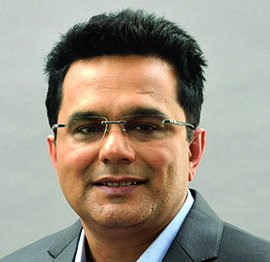We have launched two programmes: Kotak Payment Co-creation Programme and the Kotak UPI 2.0 Hackathon. The Kotak Payment Co-creation Programme helped us build an ecosystem of collaboration and innovation for startups and FinTechs in the digital payments space, says Deepak Sharma, Chief Digital Officer, Kotak Mahindra Bank in conversation with Elets News Network (ENN).
You have recently collaborated with NASSCOM to launch a platform for startups. Give us an insight into it.
This platform was launched to identify and motivate innovative startups to challenge the status quo and design innovative solutions for potential collaboration. We have launched two programmes: Kotak Payment Co-creation Programme and the Kotak UPI 2.0 Hackathon. The Kotak Payment Co-creation Programme helped us build an ecosystem of collaboration and innovation for startups and FinTechs in the digital payments space. The Kotak UPI 2.0 Hackathon was designed to cover solutions encompassing merchant and enterprise payments on the UPI 2.0 platform. These programmes have helped us identify potential partners and create payment solutions with them.
How challenging or exciting is it to be the Chief Digital Officer of Kotak Mahindra Bank?
This is both exciting and challenging. At Kotak, digital is a way of life. Our focus is to deliver value to our customers, employees and the firm by aligning people, processes and technology. Finding the right balance between security, regulations and great customer experience at speed and scale is the core of the bank. I as the Chief Digital Officer, of the bank work with cross-functional teams within the organisation along with other partners in the external ecosystem including FinTechs, regulators, government and other participants to transform the core and create a scalable and future-ready financial service business model.
What security measures banks should take to curb fraud?
Cybersecurity is of great importance in the financial sector. Different banks have varied levels of adoption of cybersecurity solutions. The focus of cybersecurity is moving from protection to real-time detection of frauds and immediate response to that. Banks have started adopting solutions related to fraud risk management, device binding, threat hunting, endpoint detection & response and threat matrix. Identity theft (phishing and vishing) is a major concern for banks. Biometric solutions (speech/facial), behavioural & step-up authentication are solutions that are widely used to address this issue.
How do you rate India’s readiness to the adoption of technologies like Artificial Intelligence (AI) & Machine Learning (ML) in banks?
Machine learning has been widely adopted in the banking industry. ML is used in advanced analytics (personalisation N=1, Nudges), risk-credit rating, fraud detection, etc. The use of AI (Optical character recognition) in Robotic Process Automation (RPA) is growing along with its use in credit assessment, authentication and advisory. AI technologies have witnessed a widespread use in Natural Language Processing (NLP) and speech recognition for chatbots, voice bots, sentiment analysis, etc. Other technologies like biometric authentication (facial/speech), object recognition in images for automation, Natural Language Generation (NLG) for automatic response generation by machines will see widespread use.
In the long run, AI technologies such as Generative Adversarial Network (GAN) to generate videos automatically for marketing, learning and development purposes, and handwriting recognition for automation of various manual processes are expected to gain momentum and widely used.
What innovations are you planning for the rest of 2019?
Our innovations are focused on providing superior customer journeys, developing and scaling up banking channels and platforms, security and authentication, lending and payments, among others. With Data Lake and Artificial Intelligence, the focus will be on leveraging the same for real-time personalisation and real-time fraud prevention. The microservices layer helps in launching new services to the end customer within a shorter period. New Application Programming Interface (API)-based products will bring in banking services through other ecosystems.
Account aggregation can be leveraged for sharing customer data through consent. We are also reimagining digital channels and transaction interfaces across the mobile app, chat and voice bots, messaging and interactive partner network. Looking at our readiness with regard to account aggregator, consent and data privacy platform along with Open banking are other priorities for us.
Elets The Banking and Finance Post Magazine has carved out a niche for itself in the crowded market with exclusive & unique content. Get in-depth insights on trend-setting innovations & transformation in the BFSI sector. Best offers for Print + Digital issues! Subscribe here➔ www.eletsonline.com/subscription/





















